












The Kessler Trauma Center at the University of Rochester-Strong Memorial Hospital is proud to provide state-of-the-art injury care to the citizens of the Finger Lakes Region of New York and beyond. As the only American College of Surgeons verified and New York State Department of Health designated level 1 trauma center in the region, the hospital serves a population of over 1.5 million residents spanning 13 counties. Strong Memorial Hospital is a 900-bed tertiary care facility that admits over 2,500 injured patients each year. The trauma center is staffed around the clock by fellowship-trained and board-certified trauma surgeons and surgical intensivists supported by orthopedic, neuro, vascular and plastic surgeons.
The facility boasts a specialized Burn-Trauma Intensive Care Unit, multiple operating rooms, modern imaging technology, a full-service blood bank, a newly renovated in-house Commission on Accreditation of Rehabilitation Facilities (CARF) accredited rehabilitation unit and a highlyexperienced team of nurses, technicians and other specialized providers. The focus on clinical excellence is supported by the Trauma Center’s commitment to community outreach, education, injury/violence prevention and research. This helps the trauma center team achieve the best possible outcomes for injured patients starting at time of injury through the rehabilitation process.
From left to right: Nicholas Bedrin, M.D.; Nicole Stassen, M.D.; Michael A. Vella, M.D., M.B.A.; Michael Nabozny, M.D.; Julius Cheng, M.D., M.P.H.; Mark Gestring, M.D.; Yanjie Qi, M.D.; Katherine Riera, M.D.As the only level 1 trauma center in the Finger Lakes region, we are proud to provide the full spectrum of cutting-edge trauma care from initial resuscitation through rehabilitation. We continue to see substantial increases in volume and our clinical outcomes fall among the best in the nation. Since 2021, we have been ranked in the top 10% of United States’ trauma centers with respect to overall major hospital complications and mortality in the American College of Surgeons’ Trauma Quality Improvement Program (TQIP) report.
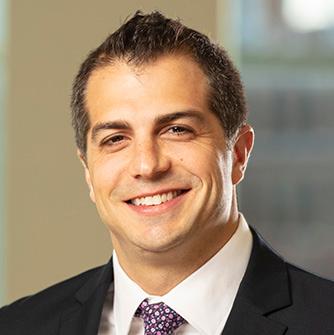
There were many exciting changes and achievements in our program over the last year, and I am proud to highlight just a few of these below.
• We were thrilled to welcome Dr. Katherine Riera and Dr. Nicholas Bedrin as new faculty members in October 2023.
• In 2023, we broke ground on the new Emergency Department at Strong Memorial Hospital. This large-scale construction project will include a state-of-the-art trauma resuscitation area specifically designed for the care of injured patients. The new facility will also include improved emergency medical services communication infrastructure, a larger clinical care space and improved access to complex imaging technologies.
• In January 2024, our program was re-verified as a level 1 trauma center by the American College of Surgeons Committee on Trauma with no deficiencies, representing the highest level of trauma care available in the United States and indicating our ability to take care of any and all traumatic injuries.
• In February 2024, our Physical Medicine and Rehabilitation program opened a new patient floor to supplement existing space in our CARF-certified rehabilitation center at Strong Memorial Hospital. This doubled the current bed capacity and represents one of relatively few hospitals across the country with in-house, full service rehabilitation units.
• We expanded our geriatric trauma program in partnership with our hospital medicine colleagues, now offering automatic geriatric
consultations to elderly patients focused on nutrition, mobility, delirium prevention and medication reconciliation in response to an increase in our geriatric trauma patient volume.
• We implemented a more robust mental health screening process utilizing the Modified Injured Trauma Survivor Screening Tool, which allows for early identification of potential mental health sequela of injury and earlier referral for inpatient and/or outpatient treatment.
• We developed multiple clinical practice guidelines to ensure we are following the most current evidence-based practices, including management of severe traumatic brain injuries, spinal cord injuries, and liver/spleen injuries to name a few. Our whole blood resuscitation protocol was also updated to allow for more liberal use in all adult patient populations based on the most recent data available.
• We worked with our interventional radiology colleagues to create a Critical Embolization Response Team (CERT) protocol to offer even faster hemorrhage control response in patients with bleeding from areas not always amenable to surgical control in the operating room.
• Our trauma program had over 30 peer-reviewed publications in major medical and surgical journals in the last calendar year.
• We saw a 280% increase in total external trauma course offerings over the last two years, equating to a 450% increase in total course
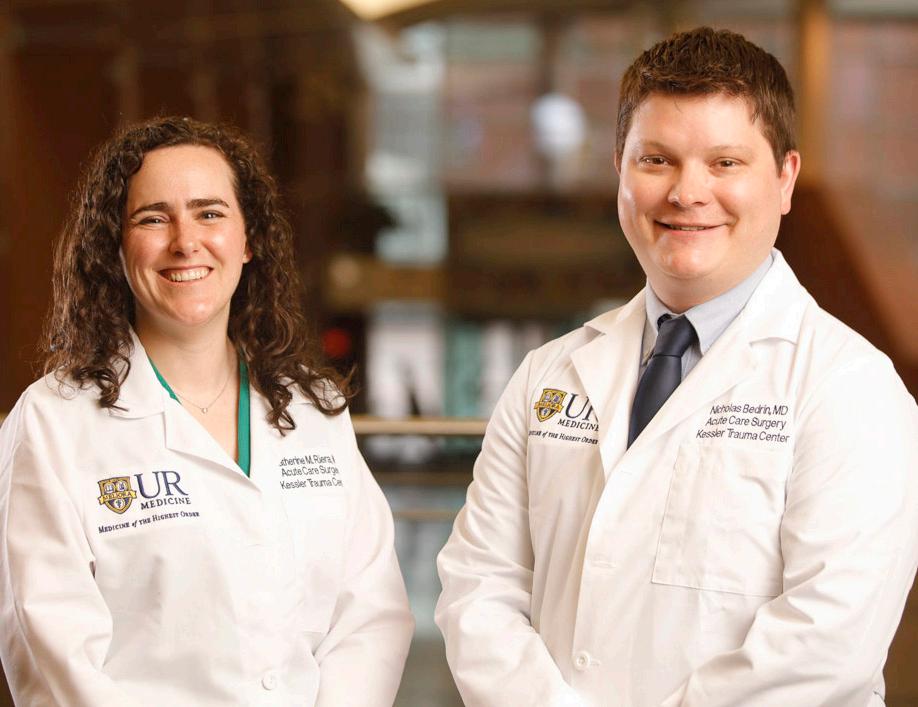
hours of trauma education provided to the region.
• Our faculty continues to lead on the local stage and beyond. I was recently appointed as the Chair of the New York State Committee on Trauma and Dr. Nicole Stassen continues to serve on the American Board of Surgery Trauma, Burns, and Surgical Critical Care Board. Many of our faculty maintain active involvement in national organizations like the American Association for the Surgery of Trauma (AAST), the Eastern Association for the Surgery of Trauma (EAST), and the American College of Surgeons Committee on Trauma (ACS-COT).
• Over the last two-years, the New York State Division of the American Trauma Society has awarded our program with the following awards: Trauma Medical Director of Distinction, Trauma Educator of Distinction, Trauma Registrar of Distinction, Injury Prevention and Outreach Coordinator of Distinction, and Trauma Performance Improvement Coordinator of Distinction.

Our Division Chief, Dr. Mark Gestring, recently won the National Safety Council 2023 Surgeon’s Award for Service to Safety.
• We continue to offer the Rural Trauma Team Development Course (RTTDC®) to non-trauma centers across our region and were asked to proctor two courses in Philadelphia in June of 2023. Our surgeons also co-directed and taught a Disaster Management and Emergency Preparedness (DMEP®) class at the State Trauma Advisory Committee Meeting in May 2022 and one in San Juan, Puerto Rico in December of 2023.
• We maintain a robust Stop the Bleed education program and remain actively engaged in violence prevention and firearm injury prevention efforts in conjunction with local advocates, legislators, and law enforcement.
• We utilize high-fidelity trauma and surgical critical care team simulations monthly to enhance training and readiness.
• Our performance improvement (PI) program, including trauma video review capabilities, compliments and enhances our clinical care. Our faculty and program staff are engaged in
national performance improvement efforts through Eastern Association for the Surgery of Trauma (EAST) as well as the New York State TQIP Collaborative and State Trauma Advisory Council (STAC). Our trauma registrars are Certified Specialists in Trauma Registries (CSTR).
• Our program remains actively involved in multiple society-sponsored multi-institutional trials, multiple ongoing local research projects, and the development of two societysponsored practice management guidelines. The Kessler Trauma Center is the lead institution in the Upstate Acute Care Surgery Research Collaborative, a group of Upstate, New York trauma centers that meets on a regular basis to facilitate multicenter research projects and discuss best practices.

 Michael A. Vella, M.D., M.B.A., F.A.C.S. Trauma Medical Director
Michael A. Vella, M.D., M.B.A., F.A.C.S. Trauma Medical Director
Surgeons:



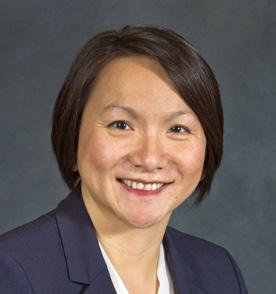

Mark L. Gestring , M.D., F.A.C.S., Professor of Surgery, Emergency Medicine and Pediatrics; Chief, Division of Acute Care Surgery
Nicholas G. Bedrin, M.D., Assistant Professor of Surgery and Pediatrics
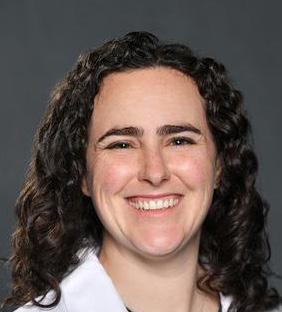
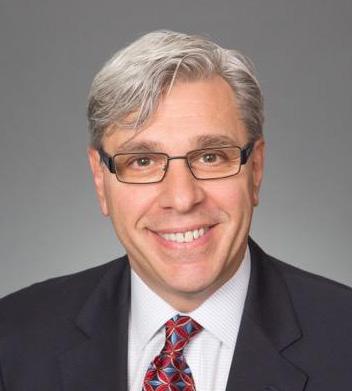
Julius D. Cheng, M.D., M.P.H., F.A.C.S., Professor of Surgery and Pediatrics; Professor of Clinical Nursing, School of Nursing
Yanjie Qi, M.D., F.A.C.S., Associate Professor of Surgery and Pediatrics; General Surgery Residency Program Director
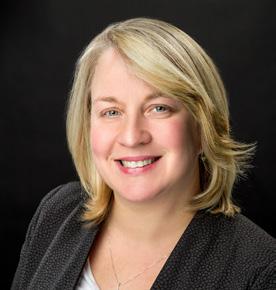

Michael Nabozny, M.D., F.A.C.S., Assistant Professor of Surgery and Pediatrics
Trauma Program Team:
Kate Dellonte, R.N., M.B.A., B.S.N., Trauma Program Manager
Adam Oplinger, R.N., B.S., C.E.N., T.C.R.N, Injury Prevention and Outreach Coordinator
Rachael Podsiadlo, R.N., B.S.N., Performance Improvement Coordinator
Trauma Registrars:
Margaret Vercruysse, L.P.N., B.S., C.S.T.R., C.A.I.S.S.
Lead Trauma Registrar
Jill Bush, L.P.N.
Katherine M. Riera, M.D., Assistant Professor of Surgery and Pediatrics
Michael Rotondo, M.D., F.A.C.S., Professor of Surgery; Associate Vice President for Administration; Chief Executive Officer; Vice Dean for Clinical Affairs
Nicole A. Stassen, M.D., F.A.C.S., Professor of Surgery and Pediatrics; Medical Director of the Kessler Family Burn/Trauma ICU; Surgical Critical Care Fellowship Director
Michael A. Vella, M.D., M.B.A., F.A.C.S., Assistant Professor of Surgery and Pediatrics; Trauma Medical Director
Becky Chatt, R.N., M.S., Trauma Program Educator
Brooke Streiff, M.H.A., Division Administrator
Tamara Englert, B.A.S., Trauma Program Administrative Assistant
Stacie Gell, B.S., C.S.T.R., C.A.I.S.S.
Katherine Perry, L.P.N.
Abby Rothwell, B.S., B.A.
Trauma Advanced Practice Providers:
Jacob Privitera, P.A., Lead Trauma APP
Nichole Coleman, N.P.
Leah Green, N.P.
Andrea Masiello, N.P.
Kelsey Potter, N.P.
Caitlin Randall, N.P.
Zachary Woughter, P.A.
Burn Trauma Intensive Care Unit Advanced Practice Providers:
Jonathan Krotz, N.P., Lead BTICU APP
Lauren Dunning, P.A.
Jessica Falk, N.P.
Paige Kuebler, P.A.
Liaisons:
Derek Wakeman, M.D., Pediatric Trauma Medical Director
Neil Blumberg, M.D., Blood Bank
Ciandra D’Souza, M.D., Hospital Medicine
David Grimes, D.O., Anesthesia
Catherine Humphrey, M.D., M.B.A., Orthopedic Surgery
Brent LaRiccia, P.A.
Sarah Jones, P.A.
Lisa Judge, N.P.
Kylie Terwilliger, N.P.
Matthew Traub, N.P.
Kaylee Maynard, PharmD, Pharmacy
Andrea Miglani, M.D., Emergency Medicine
Heather Ma, M.D., Physical Medicine and Rehabilitation
Daniel O’Connor, M.D., Radiology
Debra Roberts, M.D., Ph.D., Neuro Medicine ICU
G. Edward Vates, M.D., Neurosurgery

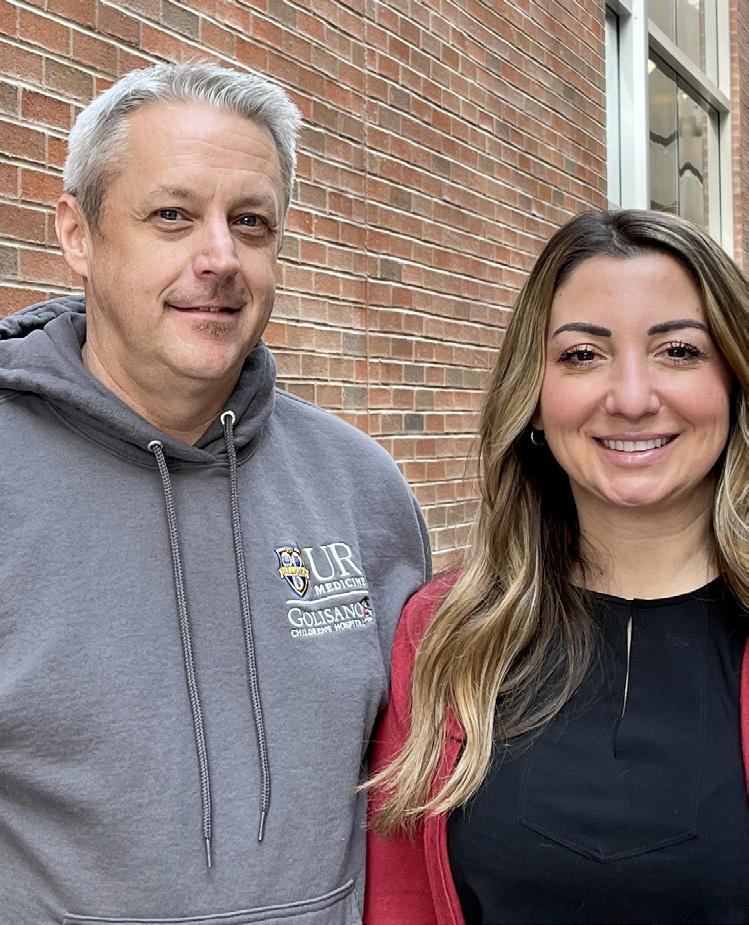

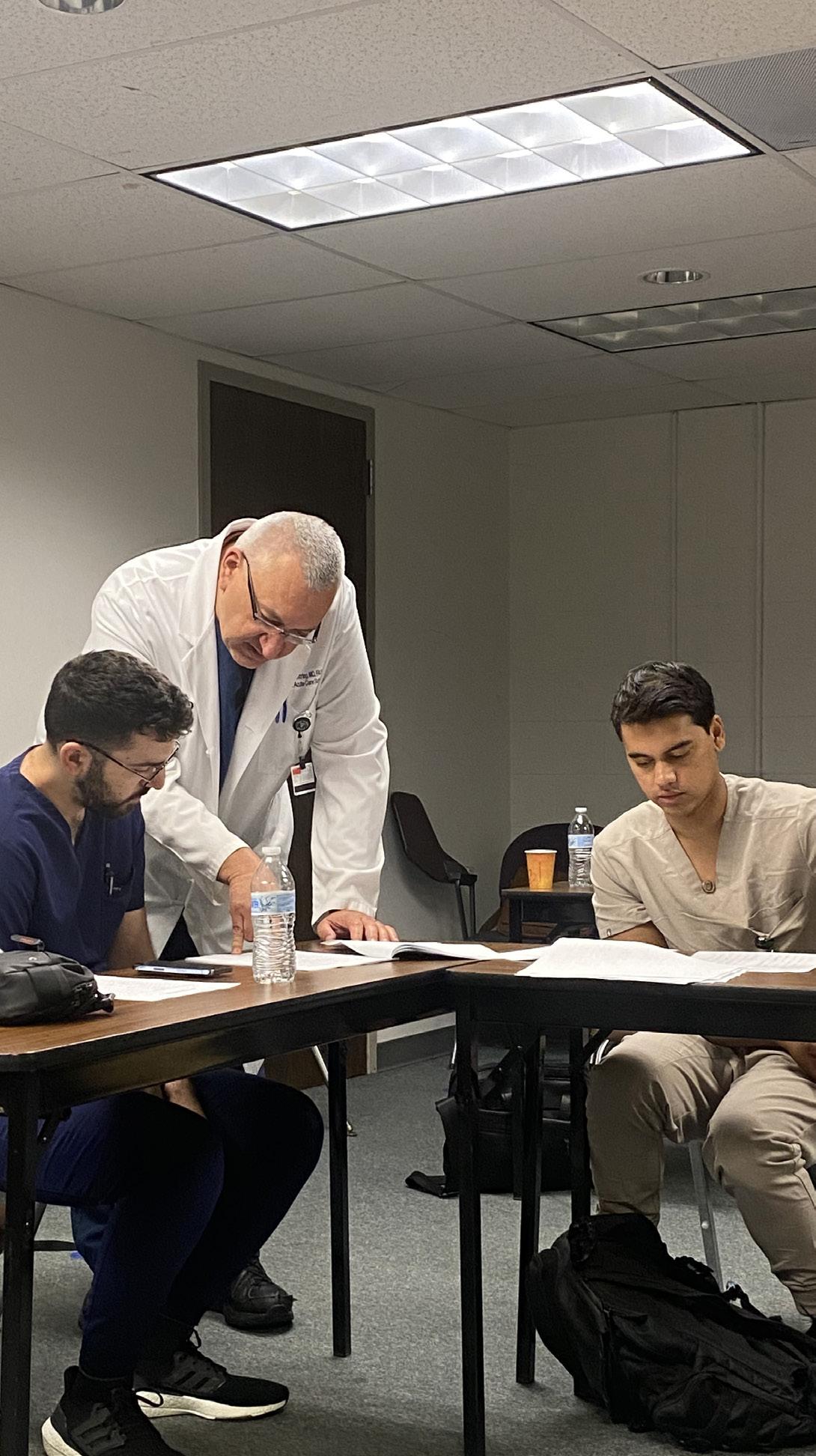
 Top left: Mobile Trauma Education Ambulance
Top right: Mark Gestring, M.D. and students during ATLS
Bottom: Trauma Simulation in Interventional Radiology Suite
Top left: Mobile Trauma Education Ambulance
Top right: Mark Gestring, M.D. and students during ATLS
Bottom: Trauma Simulation in Interventional Radiology Suite
Regular trauma-related continuing medical education efforts ensure that all providers remain current with the latest advances in trauma care. The Kessler Trauma Center at Strong Memorial Hospital is committed to teaching staff and our community partners how to stabilize and manage critically injured patients.
Advanced Trauma Life Support (ATLS®) was developed by the American College of Surgeons to provide a systematic, concise approach to trauma care that is applicable to any hospital setting. ATLS® focuses primarily on rapid assessment and initial stabilization and provides the cornerstone of management of the most critically injured patients. The Kessler Trauma Center offers this two-day course 8 times per year, including an instructor course, hosting students from across the U.S. and beyond.
Advanced Trauma Care for Nurses (ATCN®) is an advanced course designed for the nurse interested in increasing his/her knowledge in the management of the injured patient. Benefits of ATCN® training include an educational, team building, collaborative, and synchronized approach to trauma care. The Kessler Trauma Center continues to increase the number of yearly offerings due to high demand and success with the course. In 2024, the Kessler Trauma Center became an ATCN® Sister Site with ATCN® Italy to mentor them by sharing best practices, assist with building their programs, and improve nursing interventions.
This hands-on educational offering occurs at least once a month and provides an opportunity for all learners (residents, nurses, advanced providers, patient care technicians, respiratory therapists, etc.) to gain experience with trauma-specific equipment, procedural set-up, and procedural skills. Taught by experienced surgeons and trauma program staff, the course includes training on intra-osseous and complex vascular access, application of tourniquets and pelvic binders, the use of Resuscitation Balloon Occlusion of the Aorta (REBOA), ultrasound, chest tube insertion, and emergency department operative procedures, to name a few. This course is required for all surgical/trauma trainees at least once a year.
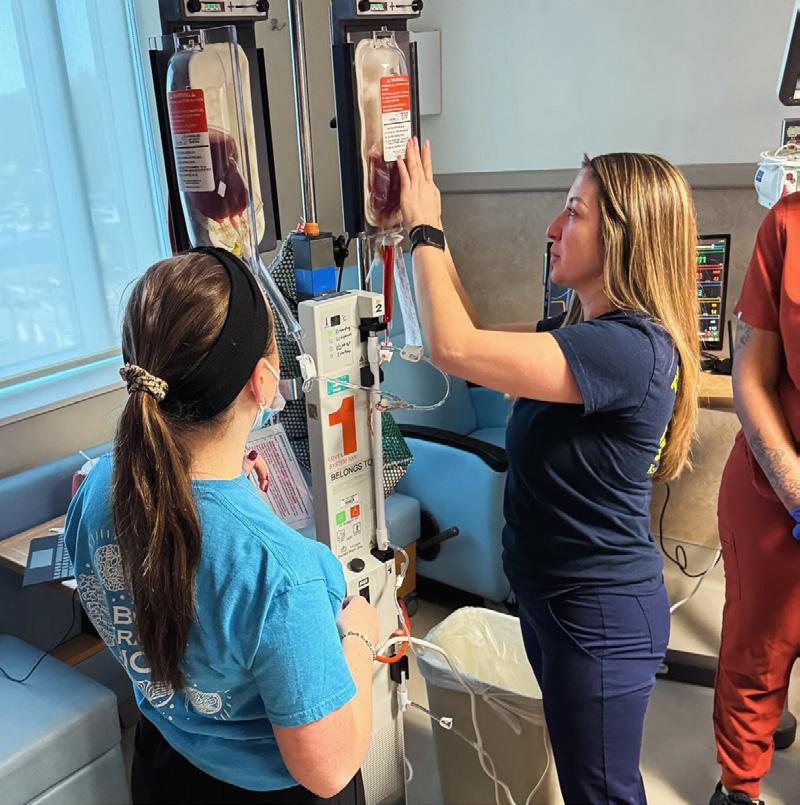

The mobile skills lab is an extension of the trauma skills lab, providing a similar experience to our regional hospital and pre-hospital partners. Our Mobile Education Unit and state-of-the-art trauma simulator allow us to teach trauma-specific skills outside of our facility to improve the overall care of injured patients in our larger region.
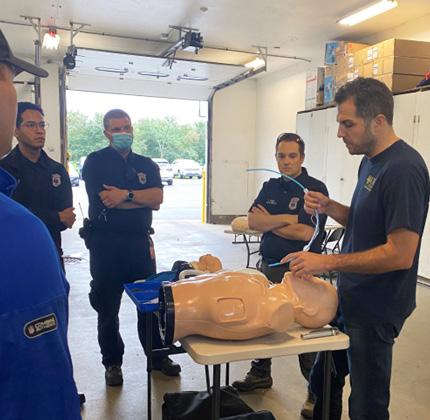
Over the last year, the Trauma Program taught 18 mobile skills labs to various EMS, law enforcement, and fire departments across the region, many of
which are taught on nights and weekends due to the agency schedules and availability.
Trauma simulation provides an opportunity to hone technical and team skills in a controlled and safe environment. Utilizing the most advanced trauma simulators, we host monthly simulations in the adult and pediatric emergency departments as well as the Trauma ICU. Simulated scenarios are based on actual trauma resuscitations in which we identified potential opportunities for improvement. Over the last year, simulation scenarios have expanded to include mass casualty incidents, patient drop-offs by private vehicle, and patient progression from the ED to the BTICU. Furthermore, one of our newest Trauma Faculty members with simulation program expertise has been appointed
to co-lead, alongside our Trauma Service Nurse Educator, efforts aimed at continuing to enhance and expand our program.
The Rural Trauma Team Development Course (RTTDC®) was developed by the American College of Surgeons and is intended to improve the quality of care in rural settings by helping non-trauma centers recognize critically injured patients and offering them tools for stabilizing these patients for transfer to a trauma center. This course is typically offered four times in the spring and four times in the fall, or as requested, to facilities in rural communities. In 2023, in addition to teaching the course throughout our region, the Trauma Program taught RTTDC at the University of Pennsylvania in
Philadelphia, PA. At this session our team mentored their staff, allowing them to start teaching the course in their region.
DISASTER MANAGEMENT AND EMERGENCY PREPAREDNESS
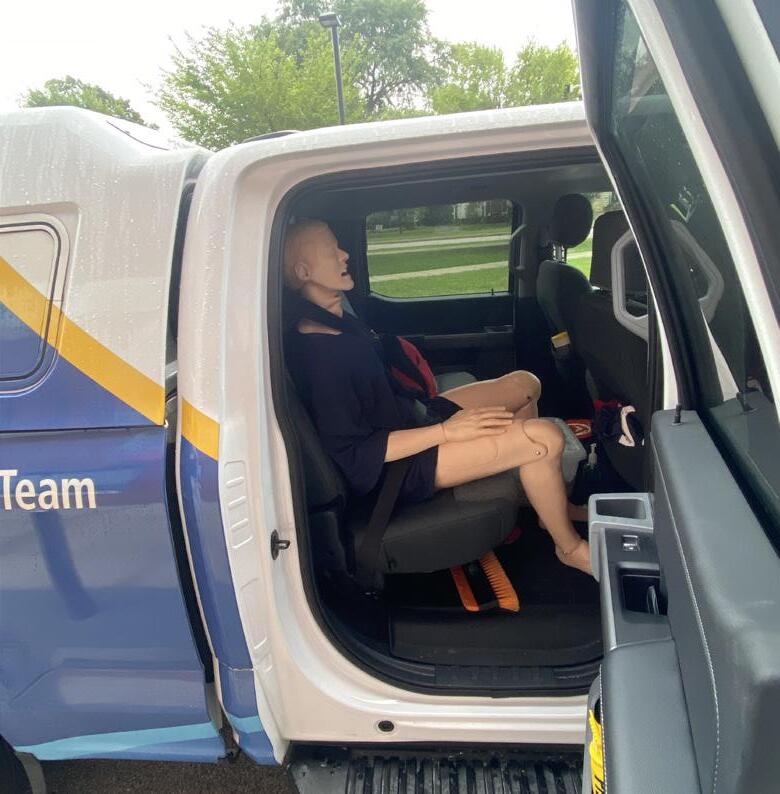
Disaster Management and Emergency Preparedness (DMEP®) teaches planning methods, preparedness, and medical management of trauma patients in mass casualty disaster situations. The Kessler Trauma

the Upstate region to offer this important course. In 2023, the Trauma Program taught DMEP in Albany for the State Trauma Advisory Committee and in Puerto Rico for the resident paper competition for a group of regional surgeons
The Trauma Education Conference is a home-grown program offering monthly trauma education on topics ranging from wound care to physical therapy to clinical management of specific injuries. Instructors include local experts as well as those on the national stage. This virtual course is also offered to our regional partners.
The Kessler Trauma Center has been a Trauma Survivors Network (TSN) site since 2022. The purpose of the TSN is to help trauma centers bring together trauma survivors and their families to connect, support each other and share resources beginning at time of injury and continuing throughout the recovery process. By recognizing that psychosocial support is sometimes as important as physical care, the TSN program works by building a community of advocates who focus on injury prevention and training health care providers to deliver holistic, high-quality care and provide necessary support aimed at improving
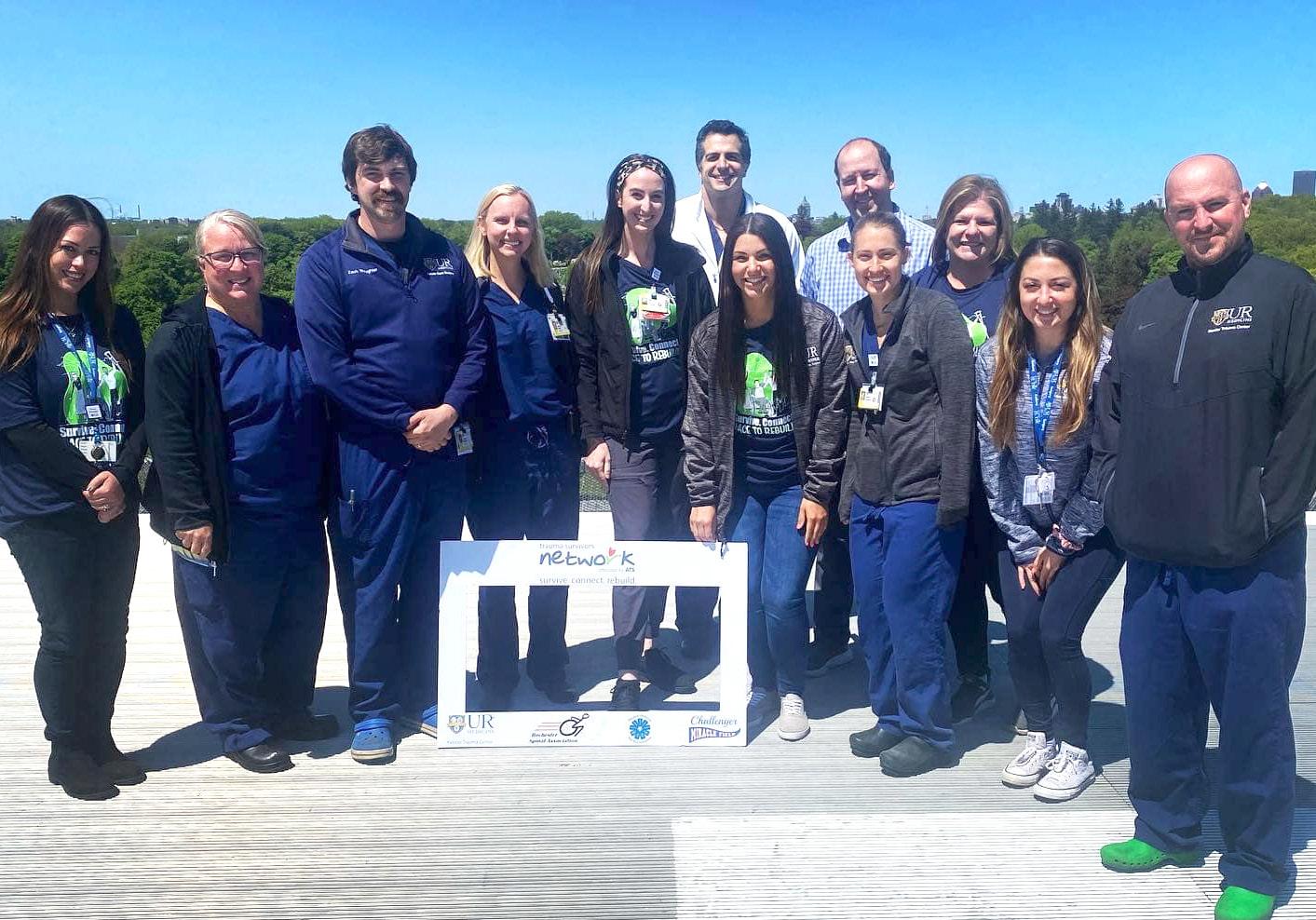
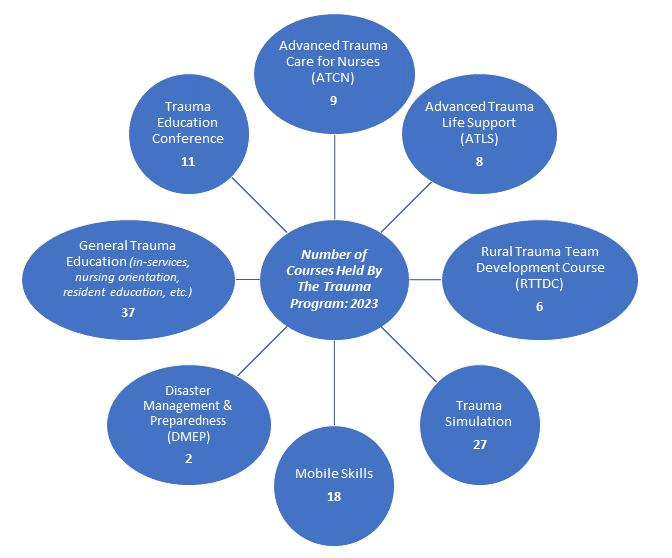
patient outcomes. Our director, Dr. Nicole Stassen, alongside our two TSN coordinators, Becky Chatt, R.N., M.S. and Brooke Streiff, M.H.A., have continued to grow our TSN program to achieve our goals of enhancing our patients’ inpatient experience and establishing local resources and support programs for post-discharge needs. Our center, in partnership with Rochester Spinal Cord Association and our UR Medicine’s Physical Medicine and Rehabilitation colleagues, is proud to host an annual Trauma Survivor’s Network Picnic. This event brings together our trauma survivors, their families, and various members of our hospital staff to reunite, share experiences, and make connections with other trauma survivors within our community. We doubled our attendance in just two
short years and look forward to continued growth of this important program. To learn more about our TSN program and to stay up to date on upcoming events e-mail us at Trauma@URMC.Rochester.edu.
The Division houses a long-standing ACGME-accredited one-year surgical critical care fellowship which provides significant flexibility for trainees to tailor their education to their unique goals. Fellows rotate through our busy burn trauma, surgical, and neuromedicine intensive care units and participate in the acute management and operative care of injured patients. We are proud to train the next generation of surgical critical care leaders.

A robust program of community outreach and injury prevention has seen staff from the Kessler Trauma Center interact with thousands of individuals throughout Rochester, Monroe County and the Finger Lakes Region, delivering a variety of programs. Our injury prevention and outreach programs are data driven, prioritizing injury trends we see through our center’s unique patient data. In 2023, we provided over 40 Stop the Bleed® classes and attended nearly 40 community events. A few highlights of the programs we deliver include:
Developed by the American College of Surgeons to provide hemorrhage control training for members of the lay public, Stop the Bleed® (STB) has been one of our most popular offerings. As one of the largest STB training centers in the Northeast, our audience includes small groups of less than ten to large groups of 300 and everything in between. We partner with Stop the Bleed® instructors from many
different first responder organizations in our area to deliver this life-saving training.
In partnership with the Monroe County Sheriff’s Office, the Responsible Gun Ownership program puts Trauma Program staff together with Monroe County Sheriff’s deputies who are experts in firearms use and law to engage with legal gun owners on the topics of keeping their firearms
safe. Points of discussion include safe firearm and ammunition storage, firearm safety around children, addressing questions related to firearm laws and offering advice about properly disposing of unwanted firearms.
The Trauma Program is embedded into the RYVP Program, which works to identify at-risk youth with a goal of eliminating recidivism by providing meaningful options to kids and their families. Based at the trauma center, this group relies on relationships developed with local and regional agencies of all types including law enforcement, hospital, school district and community support groups. This program is unique in several ways and efforts to replicate it in surrounding areas are ongoing. The Rochester Youth Violence Partnership is now part of the National Network of Hospitalbased Violence Interventions Programs (NNHVIP).
Falls are consistently the leading cause of injury in our region, especially in the 65 year and older population. We have targeted fall prevention in our injury prevention efforts in numerous ways including through our partnership with LifeSpan of Greater Rochester NY as ‘content experts’ on fall prevention during Aging Mastery Courses, creation of a “Resources for Aging Safely & Free from Injury” kit to provide at outreach events which includes educational information and support resources on various injury prevention topics, and our involvement at many workshops and conferences
with specific focus on fall prevention in our high risk populations.
Based on our center’s data, pedestrian involved accidents have been the second leading cause of injury in our region over the last two years. To prioritize our injury prevention work based on this trend, we created and now utilize educational materials and promotional items to correspond with a message of pedestrian safety. We attended over 15 community events showcasing our pedestrian safety program, providing both verbal and written education alongside various safety items such as flashing light clips, reflective armbands, and reflective zipper pulls to attendees.
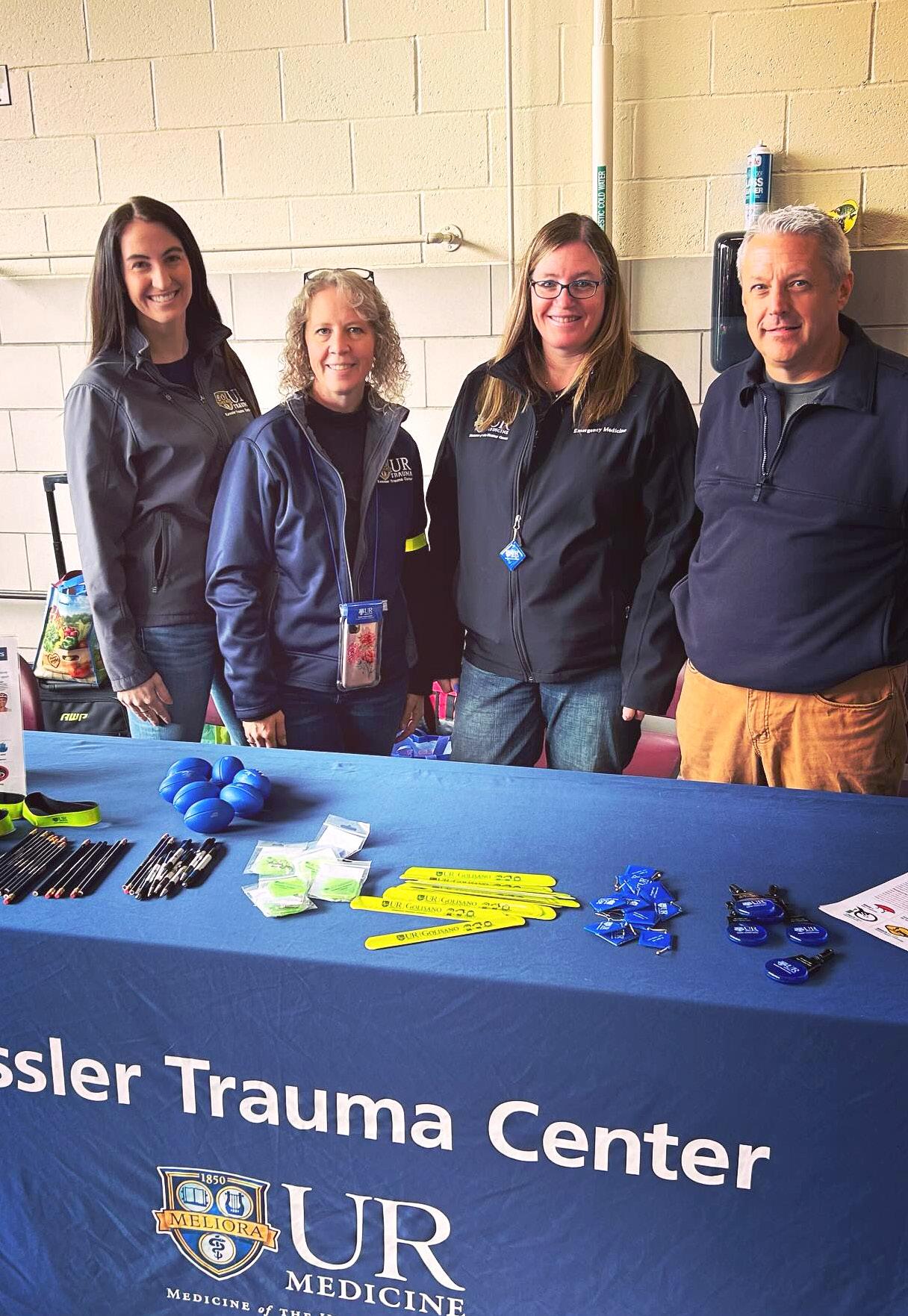
Kate Dellonte, R.N., M.B.A., B.S.N..; Margaret Vercruysse, L.P.N., B.S., C.S.T.R., C.A.I.S.S.; Tamara Englert, B.A.S.; Adam Oplinger, R.N., B.S., C.E.N., T.C.R.N at community outreach event
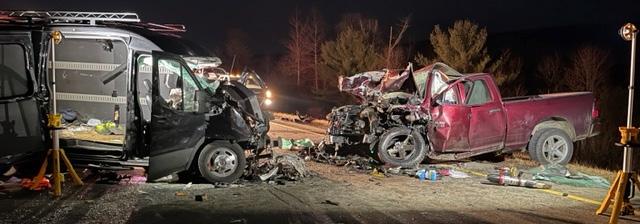
A 34-year-old male driving a commercial van was involved in a high-speed, head-on motor vehicle crash approximately 75 miles from the closest Level 1 Trauma Center. There was extensive damage to the front end of the vehicle and both of the patient’s legs were badly trapped. Multiple agencies responded to the scene, including ground emergency medical services (EMS), fire agencies, air medical services, and law enforcement. While the fire crews quickly began extricating the patient from the wreckage, the EMS providers were able to reach the patient within the vehicle to begin treatment. This included the application of tourniquets to both legs. Immediately recognizing this was going to be a prolonged extrication process for a patient who was critically injured, EMS providers contacted an emergency medicine (EM) physician from the closest local hospital. The physician on-call happened to be a paramedic and the county EMS medical director. Upon receiving
report of the patient, the EM provider responded to the scene. En-route, the EM physician contacted the Kessler Trauma Center’s on-call Trauma Surgeon to report the event and obtain further guidance. During the extrication process, the prehospital providers administered blood and plasma transfusions and gave tranexamic acid (TXA), a medication used to help clot blood when there is concern for major bleeding. A breathing tube was also placed to protect the patient’s airway. Once

extricated from the vehicle (after about two hours), the patient was flown to the Kessler Trauma Center in Rochester.
The Trauma Center was notified by Helicopter EMS that the patient was en-route and critically ill, which prompted a Level 1 (highest tier) trauma activation. With this, a multidisciplinary trauma team assembled in the trauma resuscitation area of the emergency department to prepare for this patient’s arrival. The team, when activated, includes the attending trauma surgeon, attending EM physician, trauma surgery residents, an emergency medicine resident, anesthesiologist, respiratory therapist, and specially trained nurses. In this case, as in many others, our orthopedic surgery and orthopedic spine services were also present in the trauma bay prior to patient arrival.
The patient was immediately examined and found to have a very fast heart rate and very low blood pressure (indicating major blood loss) along with significant wounds and open fractures to both of his legs. The patient was transfused with whole blood, and the massive transfusion protocol was activated to allow for the transfusion of additional blood as needed to compensate for the extensive blood loss that occurred at the scene of injury. Preliminary imaging in the trauma resuscitation unit showed multiple left and right rib fractures and a severe pelvic fracture, likely resulting in major bleeding. Our trauma and orthopedic surgery teams immediately placed a pelvic binder to control
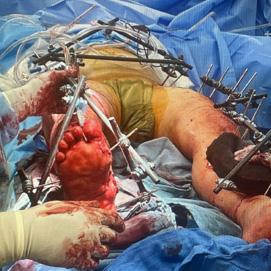
pelvic bleeding and then washed out the wounds to both legs to help prevent early infection. Once the patient was stabilized, he was brought to the CT scanner for further imaging.
The injuries found on CT scans included a spleen laceration, a large lung bruise, extensive fractures throughout both legs, multiple extensive pelvic fractures, arterial bleeding in the pelvis, multiple spine fractures, and a traumatic brain injury. Due to the active bleeding from the pelvic fracture, it was determined that the patient would benefit from an urgent interventional radiology (IR) procedure to control the bleeding from inside the pelvic blood vessel. The Critical Embolization Response Team (CERT) was activated.
Prior to IR, orthopedic surgery placed both patient’s legs in traction devices to realign the broken bones and keep them stabilized (to prevent bleeding and pain) until the patient was ultimately able to

proceed to the operating room with Orthopedic Surgery to begin repairs of the bones in both legs and pelvis. Ultimately the injuries would require a ‘staged’ approach, meaning the legs and pelvis would need to be repaired over multiple operative procedures. The first operative procedure required two orthopedic surgery attendings due to the extent of the injuries, with one surgeon operating on the left leg and pelvis and one surgeon operating on the right leg. Between hospital day one and hospital day 17, the patient went to the operating room with orthopedics a total of seven times. The patient’s right leg underwent successful fixation. Unfortunately, the damage to the left leg was far more extensive and ultimately required amputation
which was performed without complication on hospital day 22.
The patient was placed in a cervical collar for treatment of his spinal fractures and his splenic laceration was managed non-operatively. The patient’s brain injuries were closely monitored and treated non-operatively by neurosurgery. The Physical Medicine and Rehabilitation team was also involved in patient’s care to provide neuro-recovery recommendations to optimize his recovery from his traumatic brain injuries. By hospital day four, his sedation was decreased, and he was alert and following commands. By hospital day ten, he had his breathing tube removed and was awake and alert. By hospital day 13, with the assistance of the Medical Nutrition Therapy service, the patient transitioned from tube feedings to a regular diet.
The patient was discharged from the BTICU and transferred to our general trauma unit on hospital day 24. He continued to progress well throughout his hospitalization. He worked with our specially trained physical and occupational therapists throughout his recovery. He also received psychiatric and social support throughout his extended hospitalization.
The patient lived out of state, and he requested to be as close to home as possible once discharged. Our social workers worked diligently to make this happen, which entailed finding a rehabilitation center that would accept the patient in his home state and connect him with all the subspecialists
that he would require to safely recover closer to home. As he continued to improve and no longer required inpatient rehabilitation, the social work team was able to coordinate his discharge directly to his home. The patient ultimately underwent his final operative procedure on hospital day 89 and was discharged to his home on hospital day 107 with the ability to walk using a rolling walker. Prior to leaving, our patient was so thankful for his care that he recorded a special video message to be
shared with all those that were involved in his care.
Our Emergency General Surgery/Trauma Surgery Nurse Navigator followed up with the patient postdischarge once he was settled at home to check in.
The patient was doing very well, especially enjoying being able to be outdoors and going to the park with his children.
[Pictures and story used with patient’s permission.]
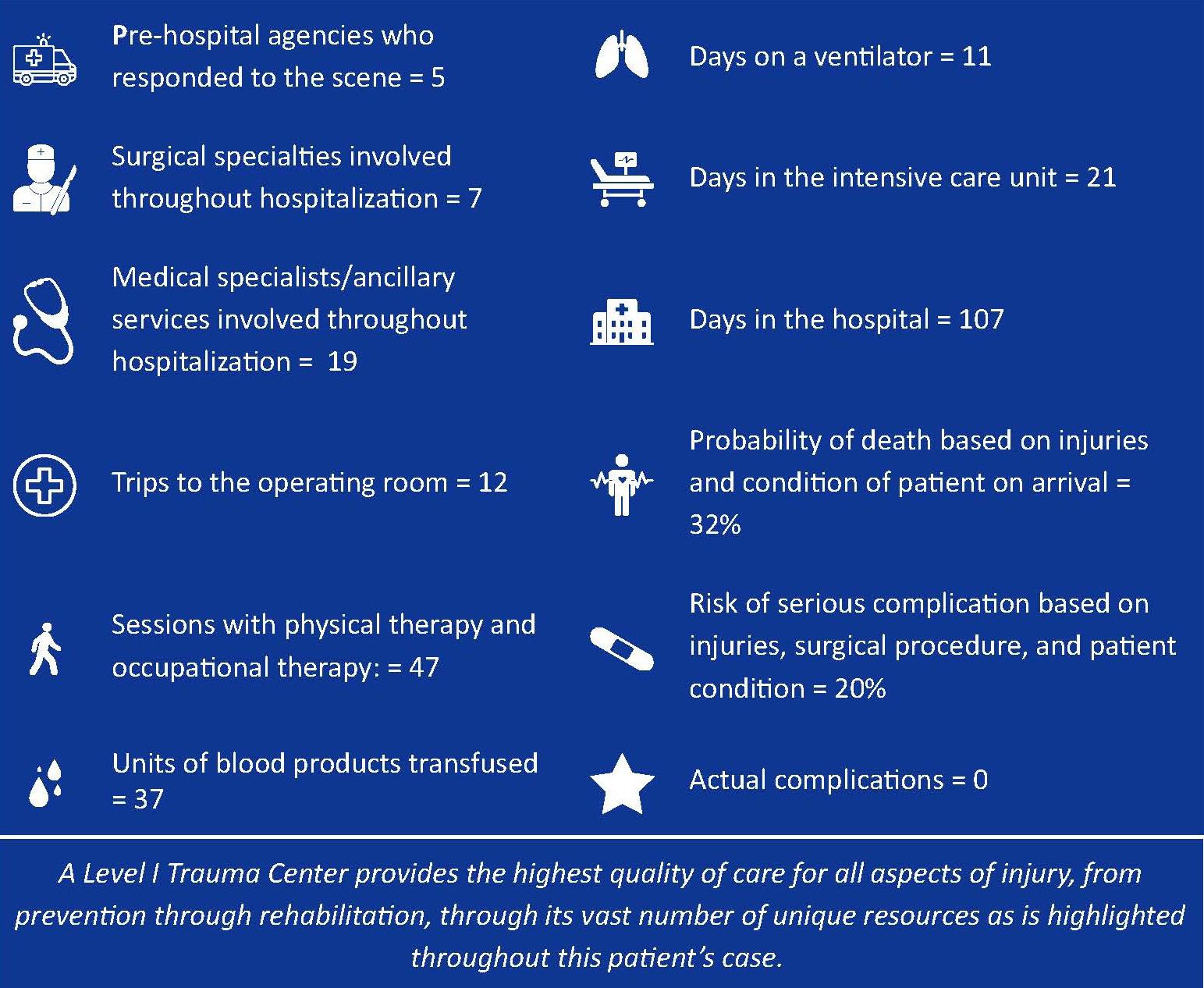


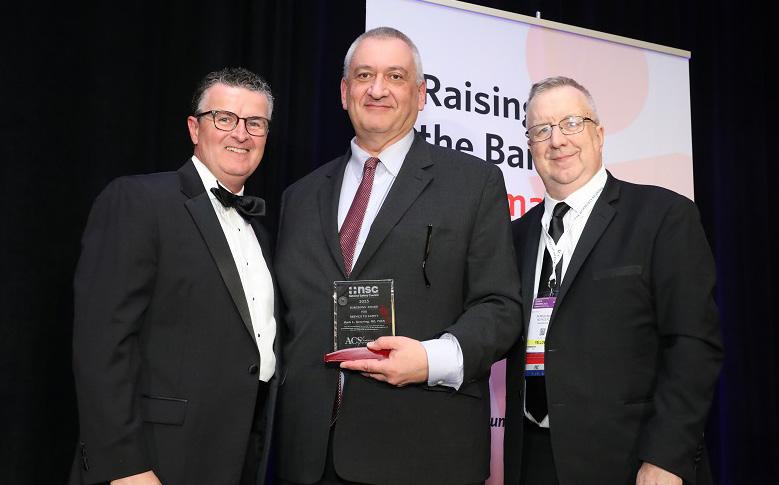 Top left: Kate Dellonte, R.N., B.S.N. & Adam Oplinger, R.N., B.S., C.E.N., T.C.R.N.
Top right: Becky Chatt, R.N., M.S., Michael A. Vella, M.D., M.B.A., F.A.C.S., & Margaret Vercruysse, L.P.N., B.S., C.S.T.R., C.A.I.S.S.
Bottom: Mark Gestring, M.D., F.A.C.S. (center) with Chair of the Committee on Trauma Jeffrey Kerby M.D., F.A.C.S. (left) & President of the American Association for the Surgery of Trauma Patrick Reilly M.D., F.A.C.S. (right)
Top left: Kate Dellonte, R.N., B.S.N. & Adam Oplinger, R.N., B.S., C.E.N., T.C.R.N.
Top right: Becky Chatt, R.N., M.S., Michael A. Vella, M.D., M.B.A., F.A.C.S., & Margaret Vercruysse, L.P.N., B.S., C.S.T.R., C.A.I.S.S.
Bottom: Mark Gestring, M.D., F.A.C.S. (center) with Chair of the Committee on Trauma Jeffrey Kerby M.D., F.A.C.S. (left) & President of the American Association for the Surgery of Trauma Patrick Reilly M.D., F.A.C.S. (right)
In January 2024, we were re-verified by the American College of Surgeons Committee on Trauma as a Level 1 trauma center (the highest designation) for another three-year term. The reviewers remarked that the trauma care provided at our center should be the gold standard for all centers. We were also to noted to have zero deficiencies within our final report – a rare feat within trauma center reviews.
QUALITY IMPROVEMENT PROGRAM (TQIP) BENCHMARK REPORTING
We have been recognized by the American College of Surgeons TQIP program as a top ten percent performing trauma center in the following categories relative to peer institutions across the United States:
• Adverse hospital events including mortality in patients with severe traumatic brain injury (Fall 2021, Spring 2022, Fall 2022).
• Adverse hospital events including mortality for all patients (Fall 2021, Spring 2022, and Fall 2022).
• Adverse hospital events for blunt multisystem patients (Spring 2022, Fall 2022).
• Complications of ventilator-associated pneumonia and unplanned return to the
operating room (Fall 2021, Spring 2022, Fall 2022).
*Adverse hospital events are defined as any major patient complication that occurs during hospitalization.
• 2023 National Safety Council Surgeons’ Award for Service to Safety –
Mark Gestring, M.D., F.A.C.S.
• American Trauma Society’s New York State Trauma Medical Director of Distinction 2023 –Michael Vella, M.D., M.B.A., F.A.C.S.
• American Trauma Society’s New York State Trauma Educator of Distinction 2023 –Becky Chatt, R.N., M.S.
• American Trauma Society’s New York State Registrar of Distinction 2023 –Margaret Vercruysse, B.S., L.P.N., C.S.T.I.R., C.A.I.S.S.
• American Trauma Society’s New York State Trauma Performance Improvement Coordinator of Distinction 2022 – Kate Dellonte, R.N., M.B.A., B.S.N.
• American Trauma Society’s New York State Injury Prevention & Outreach Coordinator of Distinction 2022 – Adam Oplinger, B.S., R.N., C.E.N.


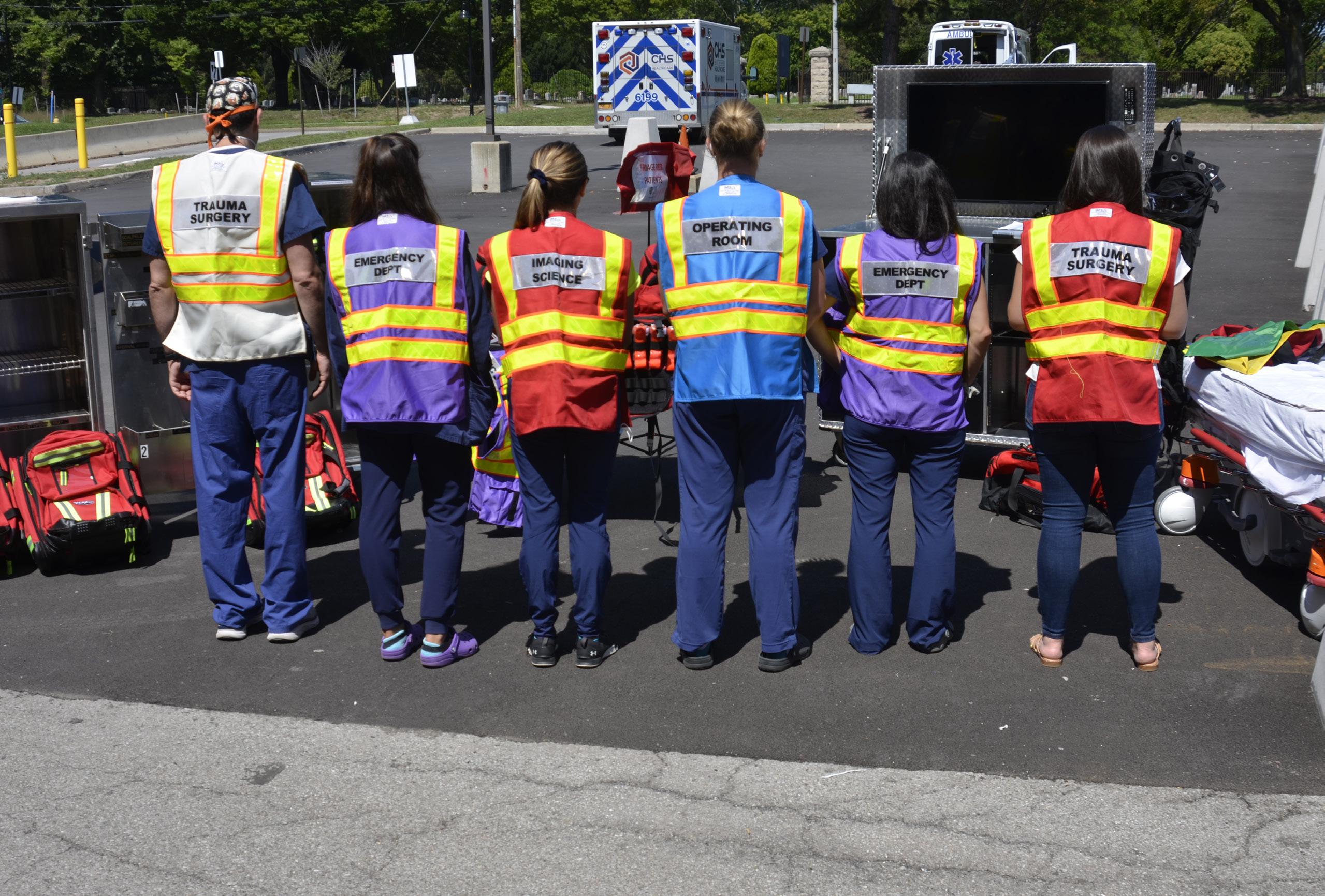 Top left and right: Participants during perioperative disaster drill
Bottom: Participants during mass casualty incident drill in the Emergency Department
Top left and right: Participants during perioperative disaster drill
Bottom: Participants during mass casualty incident drill in the Emergency Department
Performance improvement (PI) is the cornerstone of our trauma program, allowing us to ensure that we are providing exceptional, evidence-based care and maintaining the highest level of standards required for trauma center verification. As such, we continually evaluate and improve upon our already robust PI process. Trauma program leadership formally meets regularly to review all cases meeting pre-specified criteria requiring more in-depth review and to ensure compliance with institutional protocols. This process allows us to proactively identify trends in care that may indicate need for improvements prior to receiving our benchmarking reports from the Trauma Quality Improvement Program. Cases or specific trends requiring additional review are sent to formal morbidity and mortality conference, our monthly multidisciplinary conference or for broader institutional review if required. This rigorous process highlights our program and institutional commitment to the PI process and maintaining the highest standards of care.
We provide detailed feedback to our pre-hospital providers using standardized rubrics, which
include metrics of interest to EMS, recognition of exceptional care, and identified opportunities for improvement. We submit monthly data reports to our EMS agencies and engage in standing monthly meetings with regional EMS leadership and individual agencies to identify opportunities to improve regional trauma care. Furthermore, we provide regional debriefs to all members of the pre-hospital care team for extraordinary events and/or events involving multiple patients.
One of the requirements of a level 1 trauma center is that the Trauma Program participate in the development of the hospital disaster plan, including creation of a robust response to a ‘surgical disaster’. A ‘surgical disaster’ is any event in which there is potential need for multiple injured patients to undergo simultaneous urgent or emergent surgeries. To accommodate this, we expanded our disaster preparedness planning to include our perioperative services. A perioperative disaster committee was created to consider all aspects of “surgical preparedness” in conjunction with the larger hospital disaster committee. We have also held several perioperative-specific disaster drills. Operating room (OR) communication and triage, creation of multiple available operating rooms over a short period of time, and ability to maintain personnel and equipment to sustain prolonged OR surge is now a primary focus at our institution. Our unique work on this aspect of disaster
preparation is being used as a model by the American Association for Surgery of Trauma (AAST) Disaster Committee as it develops national guidelines to help hospitals prepare for such events.
In conjunction with our colleagues in Interventional Radiology (IR), we developed a protocol to ensure patient arrival time to IR for emergent procedure is < 60 minutes for any patient with concern for major bleeding. Our protocol creates a more streamlined method of communication between Trauma Surgery and IR teams, establishes an expectation of faster arrival of on-call team members to the hospital,
identifies a more efficient patient transport process, and has led to improvements in IR room readiness. The roll-out of this protocol included multiple small group sessions, educational meetings, and simulation sessions with all involved parties to test and refine the process. Since implementation of the CERT protocol, our times have decreased by over one hour.
Physical Medicine and Rehabilitation opened a new state-of-the-art Acute Brain Injury NeuroRehabilitation Unit, supplementing our existing 20-bed acute inpatient rehabilitation unit with
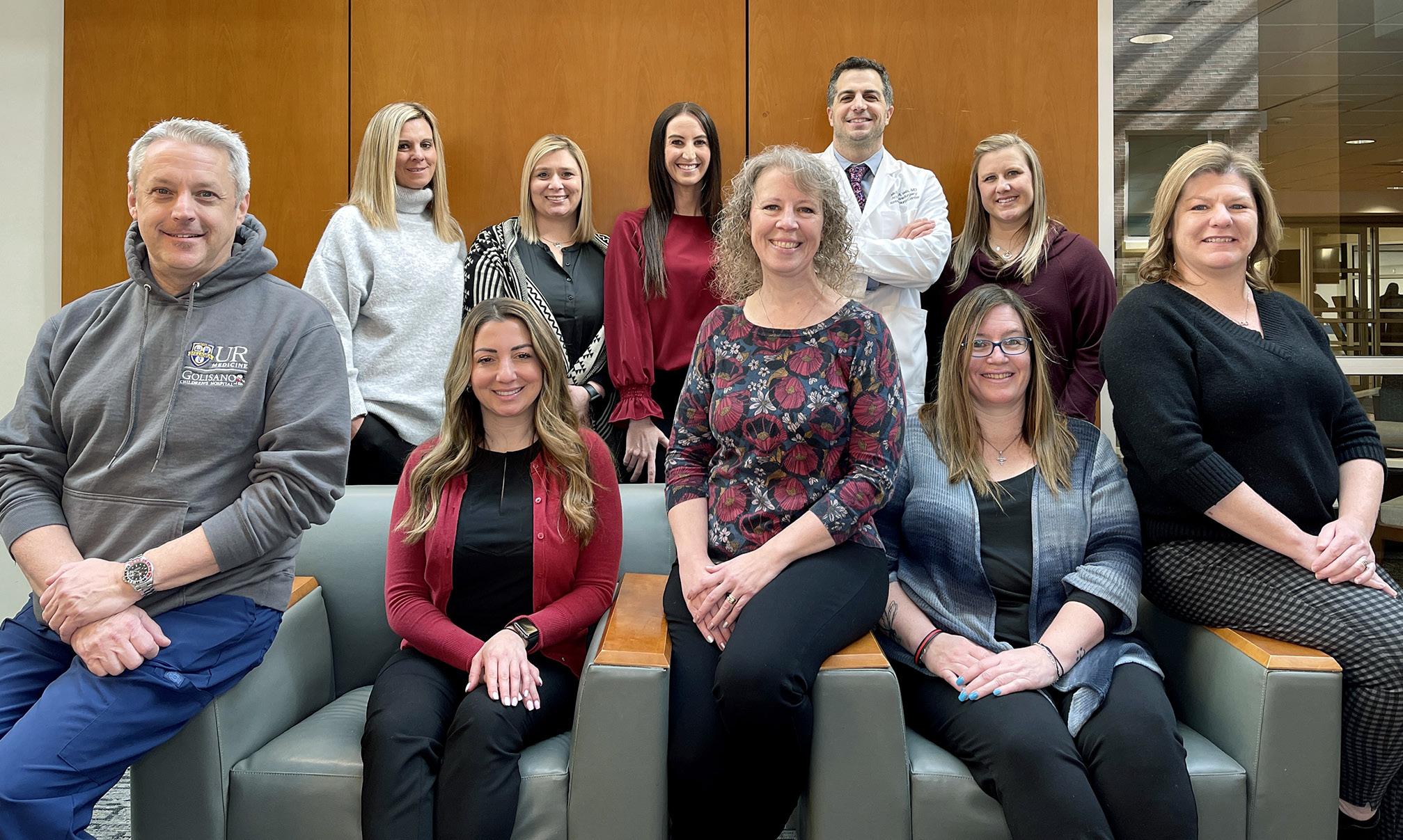
an additional 11 inpatient beds. The unit is led by board-certified and fellowship-trained physicians with expertise in brain injury rehabilitation medicine. The multidisciplinary care team is comprised of rehabilitation nurses, physical and occupational therapists, speech and language pathologists, recreational therapists, care managers, dietitians, and psychologists.
As the region’s only Level 1 trauma center, Strong Memorial Hospital is a destination for patients across the Finger Lakes Region who require advanced levels of trauma care. The new Acute Brain Injury Neuro-Rehabilitation Unit further strengthens UR Medicine’s comprehensive system of acute care and recovery for moderate to severe brain injury.
TRAUMA REGISTRY
The trauma registry is a repository of patient data for all injured patients meeting pre-specified inclusion criteria based on National Trauma Data Bank (NTDB) and New York State Department of Health standards. Over 200 data points are collected within specialized software for each patient, as well as a significant number of additional fields specific to the needs of our institution and our Trauma Program.
Patient data is abstracted by our specially trained trauma registrars. Our trauma registrars are certified in ICD10 diagnostic coding and Abbreviated Injury Scale scoring. Our registrars abstract data on a combined total of over 3000 patients per year.
Our trauma registry and registrars are the foundation of our Trauma Program.
Registry data guides our performance
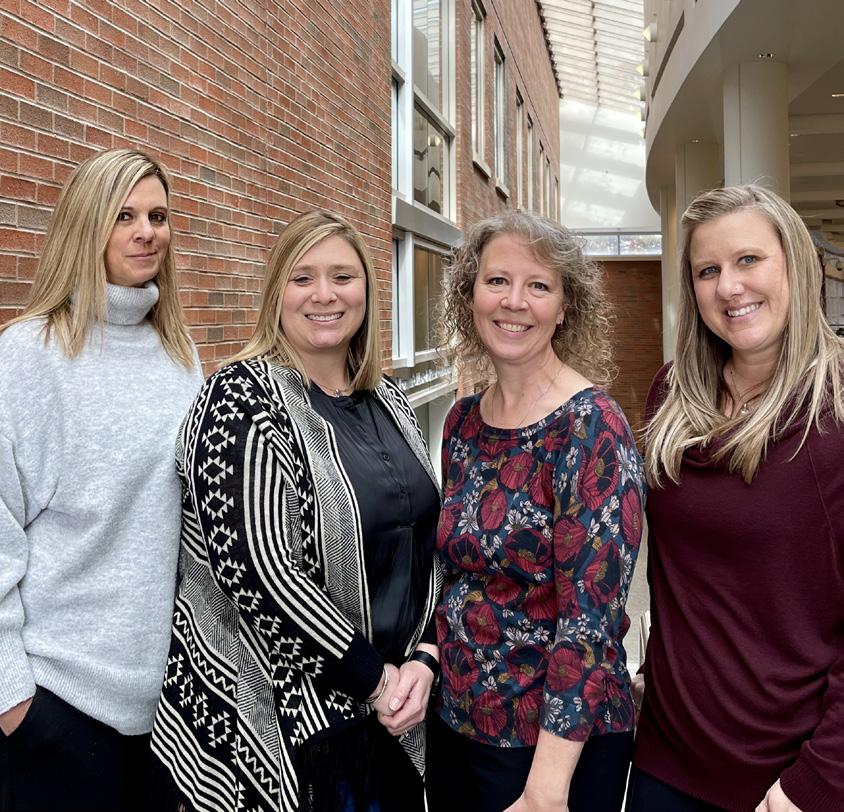
improvement initiatives and injury prevention activities and is crucial to research efforts across the institution. Furthermore, our data is utilized for our Trauma Quality Improvement Program (TQIP) benchmarking reports.
Recent Trauma Registry Highlights:
• Creation of ‘Lead Trauma Registrar’ Position –With the creation of the Lead Trauma Registrar position, we now have a team leader who is responsible for serving as a registry expert, maintaining total oversight of the registry process, and continuously working with Trauma Program leadership to improve registry efficiency and data accuracy.
• Expanded Registry Team – We recruited two additional FTE registrar positions which allows us to stay concurrent with data abstraction despite increasing patient volumes.
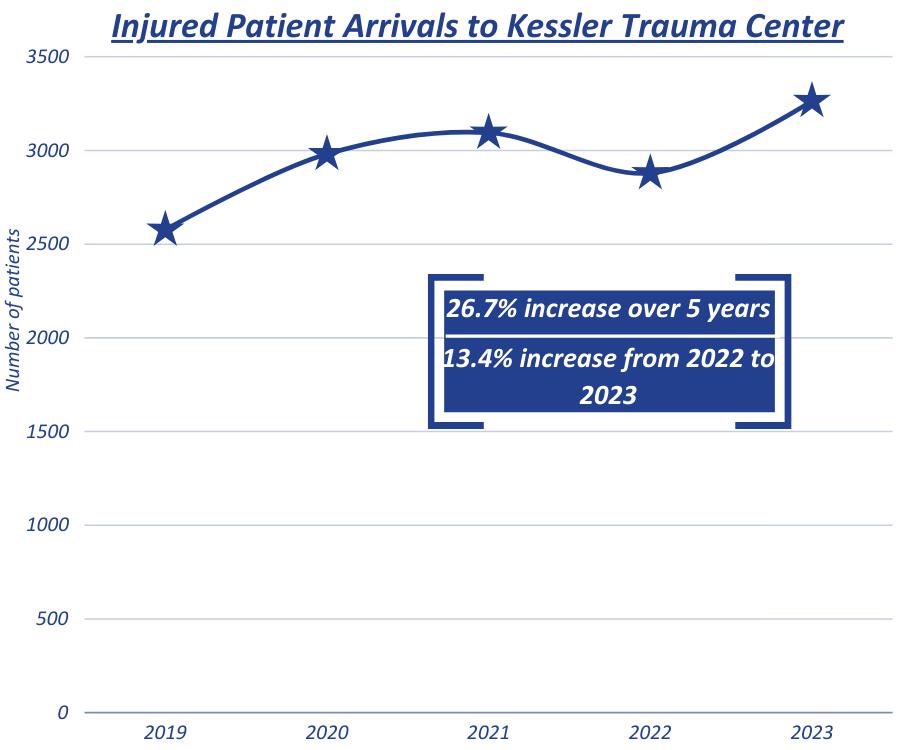
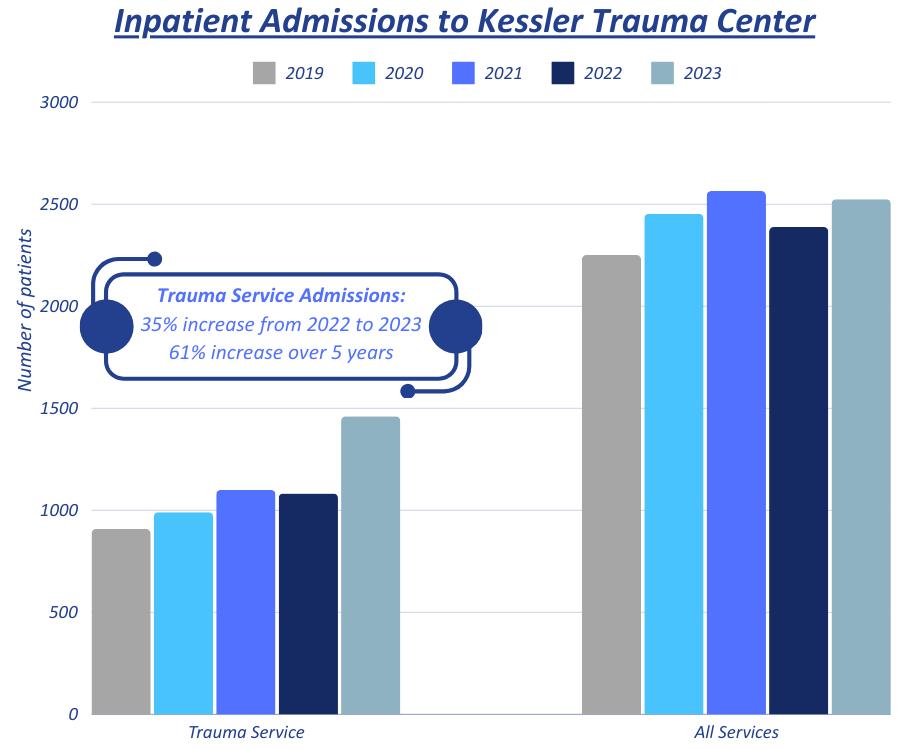
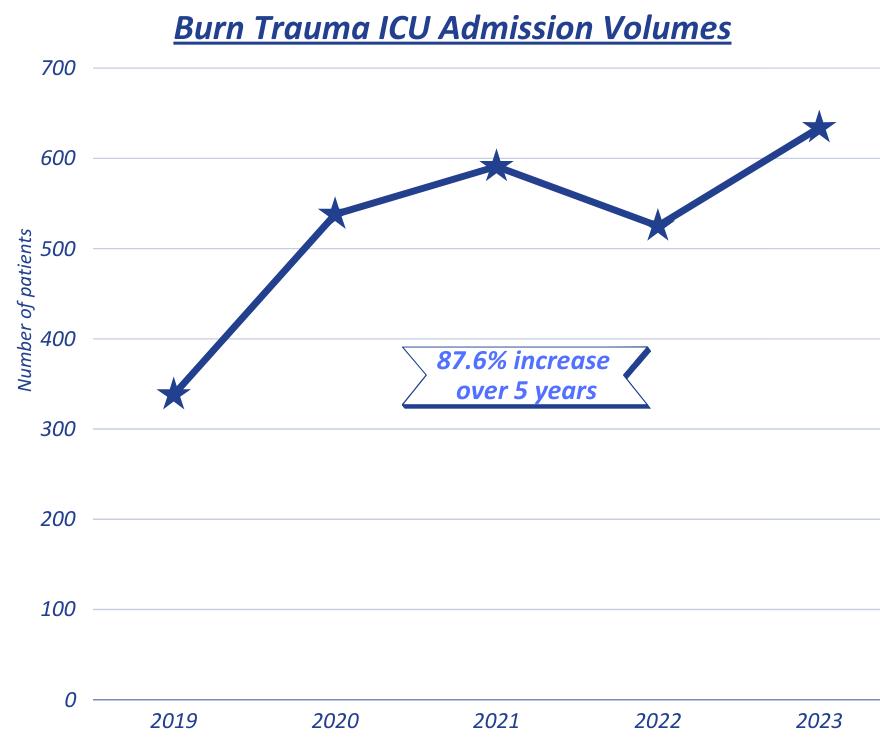


Region Served:

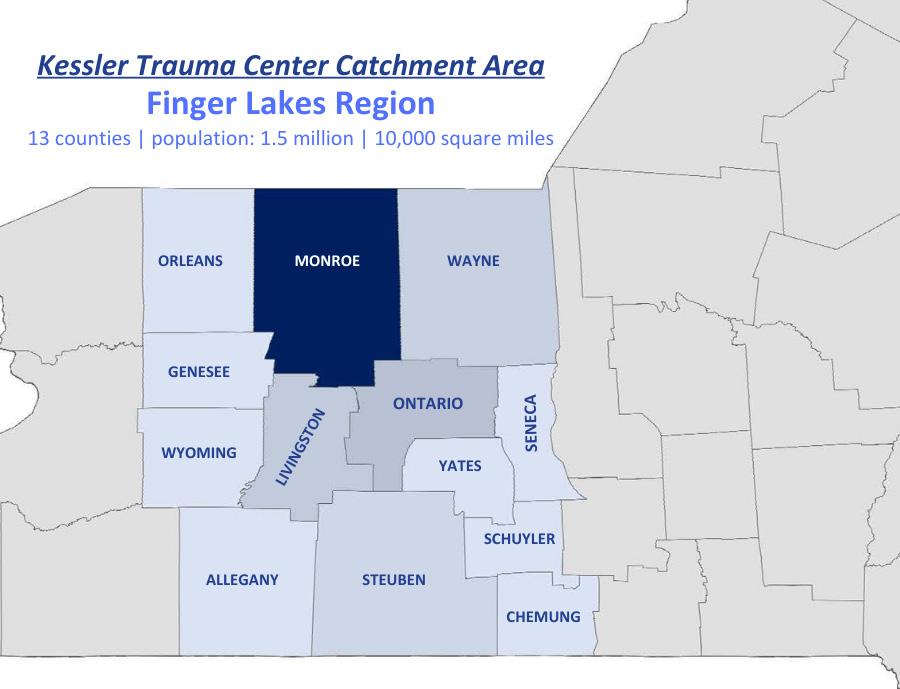

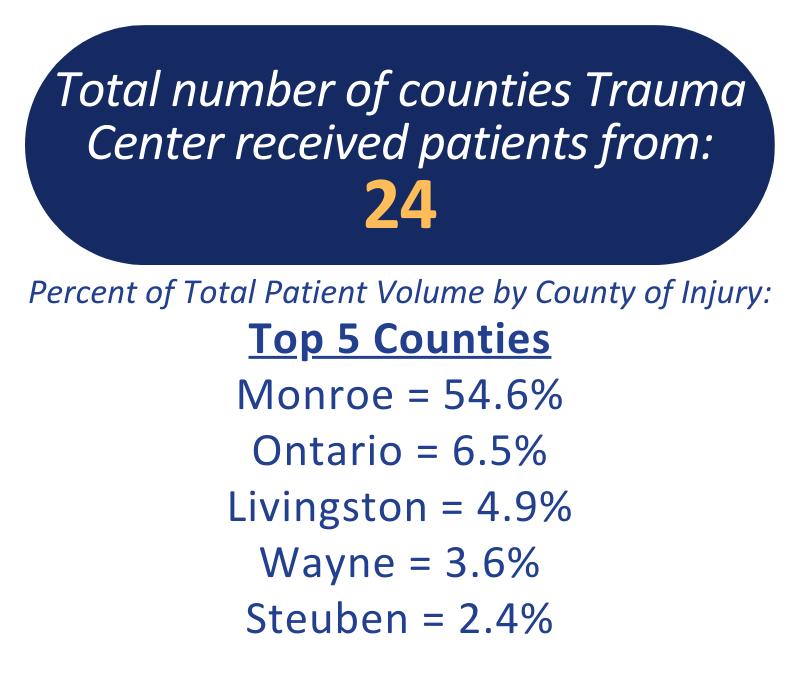
ACUTE CARE SURGERY and TRAUMA:
McLauchlan N, Ali A, Beyer CA, Brinson MM, Joergensen SM, Yelon J, Dumas RP, Vella MA, Cannon JW. Percutaneous thoracostomy with thoracic lavage for traumatic hemothorax: A performance improvement initiative. Trauma Surg Acute Care Open. 2024;9:e001298.
Succar B, Vella MA, Holena DN, Dumas RP. Navigating the challenges of vascular access in hypotensive injured patients. Surgery. 2024;175(2):559-560.
Maiga AW, Vella MA, Appelbaum RD, Irlmeier R, Fei Y, Holena DN, Dumas RP and the TVRC Investigators. Getting out of the bay faster: Assessing trauma team performance using trauma video review. J Trauma Acute Care Surg. 2024;96(1):76-84.
Rogers EJ, Reidlinger T, Loria A, Oplinger A, Raza SS, Gestring ML, Vella MA. Medical information during trauma resuscitations: Are smartphones the contemporary medical ID bracelet. J Surg Res. 2023;291:313-320.
Scrushy M, Nagaraj M, Burke K, Kuhlenschmidt K, Jeter S, Johnson D, Brown K, Edwards C, Marinica A, Vella MA, Holena DH, Park C, Dumas RP. Under the lens: Team perception of trauma video review. J Trauma Nurs. 2023;30(3):171-176.
Choron RL, Teichman AL, Bargoud CG, Sciarretta JD, Smith RN, Hanos DS, Afif IN, Beard JH, Dhillon NK, Zhang A, Ghneim M, Devasahayam RJ, Gunter OL, Smith AA, Sun BL, Cao CS, Reynolds JK, Hilt LA,
Holena DN, Chang G, Jonikas M, Echeverria K, Fung NS, Anderson A, Fitzgerald CA, Dumas RP, Levin JH, Trankiem CT, Yoon JJ, Blank J, Hazelton J, McLaughlin CJ, Al-Aref R, Kirsch JM, Howard DS, Scantling DR, Dellonte K, Vella M, et al. Outcomes among trauma patients with duodenal leak following primary versus complex repair of duodenal injuries: An Eastern Association for the Surgery of Trauma Multicenter Trial. J Trauma Acute Care Surg. 2023;95(1):151-159.
Niziolek GM, Keating J, Bailey J, Klingensmith NJ, Moren AM, Skarupa DJ, Loria A, Vella MA, Maher Z, Moore SA, Smith MC, Leung A, Shuster KM, Seamon MJ. Rethinking protocolized completion angiography following extremity vascular trauma: A prospective observational multicenter trial. J Trauma Acute Care Surgery. 2023;95(1):105-110.
Dumas RP, Vella MA, et al. Moving the needle on time to resuscitation: An EAST prospective multicenter study of vascular access in hypotensive injured patients using trauma video review. J Trauma Acute Care Surg. 2023;95(1):87-93.
McLauchlan NR, Igra NM, Fisher LT, Byrne JP, Beyer CA, Geng Z, Schmulevich D, Brinson M, Dumas RP, Holena DN, Hynes AM, Rosen CB, Shah AN, Vella MA, Cannon JW. Open versus percutaneous tube thoracostomy with and without thoracic lavage for traumatic hemothorax: A novel randomized controlled simulation trial. Trauma Surg Acute Care Open. 2023;8(1):e001050.
Gupta GK, Henrichs K, Nilsson K, Wagner S, Brown B, Masel D, Gestring ML, Vella MA, Refaai MA, Blumberg N. Reduction of anti-A and anti-B
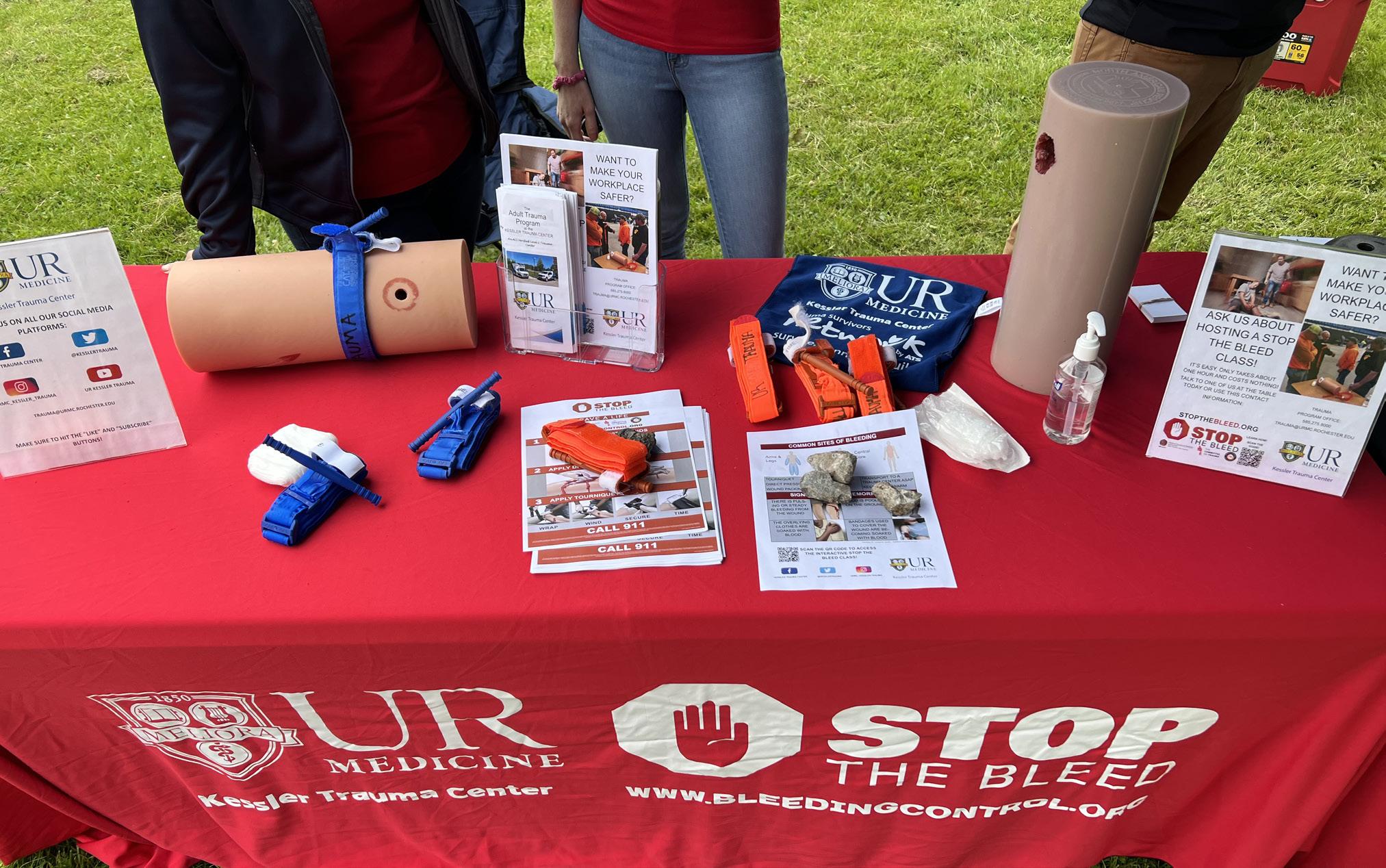
isoagglutinin titers of group O whole blood units employing an ABO antibody immune adsorption column. Transfus Apher Sci. 2023;62(3):103686.
Bankhead BK, Bichard SL, Seltzer T, Thompson LA, Chambers B, Davis B, Knowlton LM, Tatebe LC, Vella MA, Dumas RP. Bias in the trauma bay: A multicenter qualitative study on team communication. J Trauma Acute Care Surg. 2023;94(6):771-777.
Marinica AL, Nagaraj MB, Elson M, Vella MA, Holena DN, Dumas RP. Evaluating emergency department tube thoracostomy: A single-center use of trauma video review to assess efficiency and technique. Surgery. 2023;173(4):1086-1092.
Keating JJ, Klingensmith N, Moren AM, Skarupa DJ, Loria A, Maher Z, Moore SA, Smith MC, Seamon MJ, and the Fasciotomy Group Investigators J Am Coll Surg. 2023;236(5):1037-1044.
Kruser JM, Ashana DC, Courtright KR, Kross EK, Neville TH, Rubin E, Schenker Y, Sullivan DR, Thornton JD, Viglianti EM, Costa DK, Creutzfeldt CJ, Detsky ME, Engel HJ, Grover N, Hope AA, Katz JN, Kohn R, Miller AG, Nabozny MJ, et al. Defining the time-limited trial for patients with critical illness: An official American Thoracic Society Workshop Report. Ann Am Thorac Soc. 2024;21(2):187-199.
Kheirbek T, Hashmi DL, Bankhead BK, Holena DN, Winfield RD, Zarzaur BL, Hartwell J, Stassen NA, Foster SM. To leave or not to leave: American Association for the Surgery of Trauma (AAST) panel discussion on personal, parental, and family leave. Trauma Surg Acute Care Open. 2023;8(1):e001104.
Kelley KM, Toscano N, Gestring ML, et al. Disaster planning for a surgical surge: When mass trauma threatens to overwhelm your operating rooms. Trauma Surg Acute Care Open. 2023;8(1):e001224.

Doucet J, Shatz DV, Kaplan LJ, Bulger EM, Capella J, Kuhls DA, Fallat M, Remick KN, Newton C, Fox A, Jawa R, Harvin JA, Blake DP, Bukur M, Gates J, Ficke J, Gestring ML, and the American Association for the Surgery of Trauma Disaster Committee. Are trauma surgeons prepared? A survey of trauma surgeons disaster preparedness before and during the COVID-19 pandemic. Trauma Surg Acute Care Open. 2023;8(1):e001073.
ORTHOPEDIC SURGERY:
Samborski SA, Haws BE, Karnyski S, Soles G, Gorczyca JT, Nicandri G, Voloshin I, Ketz JP. Early outcomes of proximal humerus fractures in adults treated with locked plate fixation compared with nonoperative treatment: An age-, comorbidity-, and fracture morphology-matched analysis. J Orthop Trauma. 2023;37(3):142-148.
Haws BE, Samborski SA, Karnyski S, Soles G, Gorczyca JT, Nicandri GT, Voloshin I, Ketz JP. Superior outcomes with reverse shoulder arthroplasty versus nonoperative management for proximal humerus fractures: A matched cohort analysis. J Orthop Trauma. 2023;37(6):e247-e252.
Haws BE, Samborski SA, Karnyski S, Soles G, Gorczyca
JT, Nicandri GT, Voloshin I, Ketz JP. Risk factors for loss of reduction following locked plate fixation of proximal humerus fractures in older adults. Injury. 2023;54(2):567-572.
Patel UJ, Dondapati A, Carroll T, Soin S. Technical trick: Buttress plate fixation of comminuted capitellum fractures with combined suture repair of the lateral ulnar collateral ligament. JSES Rev Rep Tech. 2023;3(4):576-582.
Haws BE, Karnyski S, DiStefano DA, Soin SP, Flemister AS, Ketz JP. Reduction of posterior malleolus fractures with open fixation compared to percutaneous treatment. Foot Ankle Orthop. 2023;8(3):24730114231200485.
Patel UJ, Shaikh HJ, Brodell JD, Coon M, Ketz JP, Soin SP. Increased neighborhood deprivation is associated with prolonged hospital stays after surgical fixation of traumatic pelvic ring injuries. J Bone Joint Surg Am. 2023;105(24):1972-1979.
Shaikh HJ, Brodell JD, Soin SP. Social media perceptions of hip fractures: A two-year crosssectional analysis. Injury. 2023 54(4):1176-1179.

Dunbar RP, Egol KA, Jones CB, Ostrum RF, Mullis BH, Humphrey CA, et al. Locked plating versus nailing for proximal tibia fractures: A multicenter RCT. J Orthop Trauma. 2023;37(4):155-160.
Dunbar RP, Egol KA, Jones CB, Ertl JP, Mullis B, Perez E, Collinge CA, Ostrum R, Humphrey CA, et al. Locked lateral plating versus retrograde nailing for distal femur fractures: A multicenter randomized trial. J Orthop Trauma. 2023;37(2):70-76.
Bernstein DN, Ramirez G, Thirukumaran CP, Flemister AS, Oh IC, Ketz JP, Baumhauer JF. Clinical improvement following operative management of ankle fractures among patients with and without moderate to high depressive symptoms: An analysis using PROMIS. Foot Ankle Orthop. 2023;8(1):24730114221151077.
Neumaier M, Kohring J, Ciufo D, Ketz JP. Technique and early outcomes for high-energy calcaneus fractures treated with staged external fixation
to combined open reduction internal fixation and subtalar arthrodesis. J Orthop Trauma. 2022;36(11):e412-e417.
Breitenbach M, Phan A, Botros M, Paul D, Molinari R, Menga E, Mesfin A. The fourth column of the spine: Prevalence of sternal fractures and concurrent thoracic spinal fractures. Injury. 2022;53(3):10621067.
Furst T, Schmidt T. Costs, length of stay and inpatient complications of early surgical decompression after spinal cord injury in a geriatric cohort. J Clin Neurosci. 2023;118:60-69.
Ellens NR, Susa S, Hoang R, Love T, Jones J, Santangelo G, Bender MT, Mattingly TK. Comparing outcomes for emergency cranial neurosurgical procedures performed “during hours” and “after hours”. World Neurosurg. 2023;181:e703-e712.

Adam Oplinger, R.N., B.S., C.E.N., T.C.R.N., teaching Stop the Bleed at the United States Attorney’s Office for the Western District of New York’s Rochester Branch
EMERGENCY MEDICINE:
Armañanzas R, Liang B, Kanakia S, Bazarian JJ, Prichep LS. Identification of concussion subtypes based on intrinsic brain activity. JAMA Netw Open. 2024;7(2):e2355910.
Zuidema TR, Bazarian JJ, Kercher KA, Mannix R, Kraft RH, Newman SD, Ejima K, Rettke DJ, Macy JT, Steinfeldt JA, Kawata K. Longitudinal association of clinical and biochemical biomarkers with head impact exposure in adolescent football. JAMA Netw Open. 2023;6(5):e2316601.
Bazarian JJ, Abar B, Merchant-Borna K, Pham D, Rozen E, Mannix R, Kawata K, Chou Y, Stephen S, Gill JM. Effects of physical exertion on early changes in blood-based brain biomarkers: Implications for the acute point of care diagnosis of concussion. J Neurotrauma. 2023;40(7-8):693-705.
Meyers SP, Hirad A, Gonzalez P, Bazarian JJ, Mirabelli M, Rizzone K, Ma HM, Rosella P, Totterman S, Schreyer E, Tamez-Peña JG. Clinical performance
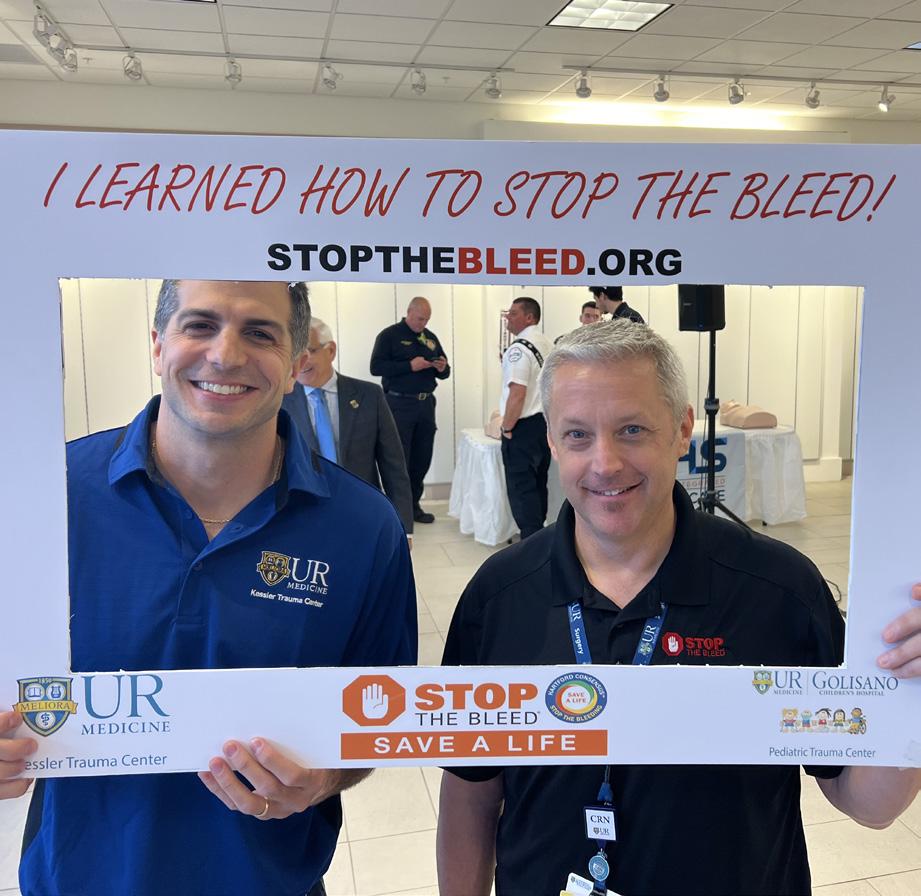
of a multiparametric MRI-based post concussive syndrome index. Front Neurol. 2023;14:1282833.
Bouche ML, Conley G, Nowlin J, Qiu J, Kawata K, Bazarian JJ, Meehan WP, Mannix R. Titrating the translational relevance of a low-level repetitive head injury model. Front Neurol. 2022;13:857654.
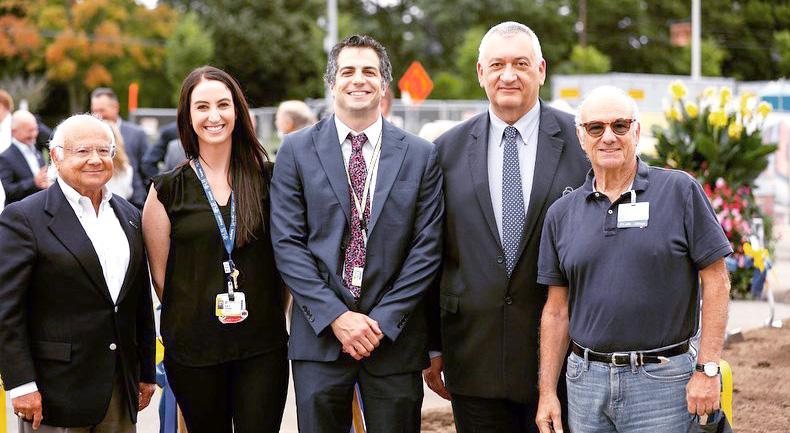
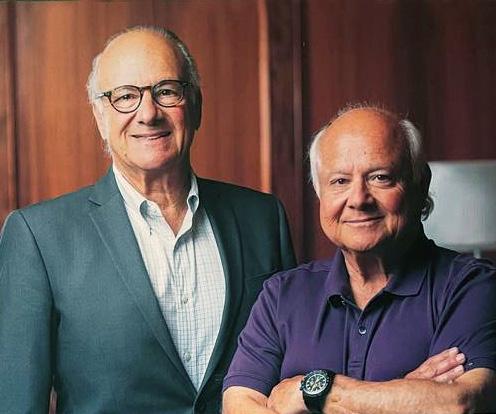
For many years Laurence and Dennis Kessler have dedicated themselves to helping people in their time of greatest need. Through their efforts and those of the managers and employees of the Kessler Group, Inc., The Laurence and Dennis Kessler Regional Trauma Unit in Strong Memorial Hospital’s Emergency Department was dedicated in 1997. In 2003, the Kessler Family, LLC employees joined in fundraising efforts for the first time, initiating a new and generous commitment to name the BurnTrauma Intensive Care Unit. In 2010, the Kessler Trauma Center was named in honor of the Kessler Family to acknowledge their generosity and extraordinary commitment to injury care in the Finger Lakes region. Successful businessmen, philanthropists, and individuals dedicated to the health of the region, the Kesslers have built an invaluable legacy for the Rochester community and beyond. The charitable works of their employees exemplify their compassionate and generous spirit.
The Kessler Trauma Center relies on the generous support of past patients and their families as well as friends, health professionals, alumni, and community residents. Gifts to the Center have a tremendous impact. Funds are used to educate the next generation of trauma care providers, improve patient care and to support the development of innovative community outreach programs.
The Kessler Trauma Center, as a part of the University of Rochester Medical Center, is a not-for-profit organization and all gifts made to the Center are deductible according to IRS guidelines.
Please contact Kerrie Merz to learn more about how you can help support this important work. (585) 273-2766 Kerrie_Merz@rochester.edu


As the area’s only Level 1 Trauma Center, the team at Strong is proud to provide state-of-the-art injury care to residents of Rochester, Monroe County and the surrounding region. The new trauma resuscitation unit, a critical part of the expansion project, was designed from the ground up to meet the challenges of modern trauma care. The unit will be significantly larger and will provide immediate access to advance imaging and treatment modalities.
TRAUMA CENTER DEPARTMENT OF SURGERY601 Elmwood Avenue
Rochester, NY 14642
 KESSLER
KESSLER